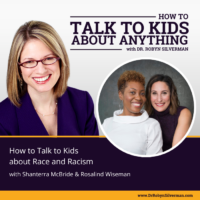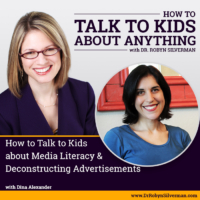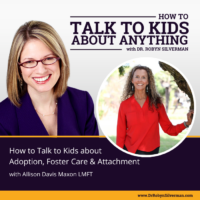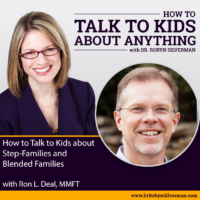Podcast: Play in new window | Download
Subscribe: Apple Podcasts | RSS | More
How to Talk to Kids About Differences and Inclusion

How do we talk to kids about diversity and inclusion? Beth Leipholtz, inclusion and accessibility advocate discusses what to consider when our own child has a disability as well as how to answer other children’s tough questions about a child’s disability or difference.
Special guest: Beth Leipholtz
How do we talk to kids about children who have differences like spina bifida, fragile X syndrome, autism or who are deaf or blind? Many times when children ask, out of curiosity, about a child’s difference that they see on the playground, at school or in a store, some adults are quick to shush that child out of fear of embarrassing the other child, the other parent or themselves. It can catch us offguard and we may not know what to say. In chapter 5 of my book, which is on talking to kids about diversity and inclusion, I highlight one of my very best friend’s children, Nate, who has Cerebral Palsy and Hydrocephalis, and is now a teen who is happy to tell you about his differences—but it’s not always that way—so how do we talk to our children, when they DO have a difference, about that difference so that they aren’t ashamed and they know that it’s simply part of what makes them who they are– but not all that they are. For this, we are talking to Beth Leipholtz.
Beth Leipholtz is an inclusion and accessibility advocate who believes in creating a more accepting world for our children. As the hearing mother of a deaf child, Beth is raising her son, Coop, bilingually in both hearing and Deaf cultures. She shares her parenting journey on TikTok, YouTube, Facebook and Instagram, where she has built a community of more than 1 million people around disability inclusion. She lives with her family in Minnesota. In addition to spending time with her family, Beth enjoys Minnesota summers, photography, iced Americanos, CrossFit, and a good old-fashioned book. You can follow her online at @beth_and_coop.
Important Messages:
- Start talking to kids about differences at age two or three- kids are really starting to be around their peers more. And asking “why” questions all the time. From a young age, they’re just capable of so much more than we necessarily might think they are.
- Kids asking “why” questions- Why is that child spinning in circles?- in that moment, a lot of parents are, don’t know what to say because they’re worried that they are going to offend somebody or they don’t know what to say because they don’t know the answer. Need to be willing to step up and have the conversation—parent of the child with the disability can sometimes step in. Or look it up when you get home. Need to read the social cues- if the parent or child don’t seem open to questions – maybe we can do a little bit of research on this when we get home and I can try to give you an answer then versus just being like, it’s not the time to ask questions.
- Can also ask your own child- “there are so many different things that, that children might use crutches for. Like, what do you think that a child might use crutches for?” Or “remember your brother broke his leg once, that was a reason why they used crutches. But there are other reasons. Sometimes kids can’t walk and they were born that way.” And being able to then use that kind of language so that they understand that this is, this can be a difference in a variety of ways. “Sometimes it’s temporary, sometimes it’s permanent, sometimes it’s has an extended period of time and then a child learns to walk on their own because their development has been delayed. And that, that would be a time where you could say, if you’re curious about that, then we can, we can look those kinds of reasons up. Why would somebody use crutches? Would you wanna be able to do that?” So even if it’s not specific to that child, it can be the impetus to talk about something more globally and, and get that child on board.
- Being able to just relate things back to what they know is kind of like one of the main things that I like to mention too. I mean, a lot of kids, you know, know what glasses are. They know that they help you see, and that’s not something that they like question that often. And so when I do see kids, you know, wondering what’s on Cooper’s head or what, you know, what’s going on, I like to say, you know, “they’re kind of like glasses, but for his ears, like, glasses help you see, and these help them hear.” And more often than not, that’s the perfectly acceptable answer and they get it. And it’s simple enough for the younger kids, but you know, then you have the like kind of eight to 12 age range where like they want to know more, they wanna understand how it works. Yes. And so I think it really depends on the, the age of the child that you’re talking to as well.
- “Bu why did this happen?” A child may ask of themselves. “Something is in your DNA,” which I talk about in my book too, and explain it in like a kid friendly way is a little bit different. And that’s why you can’t hear, but mom can. But I think it’s instilling that confidence too to be like, “this is who I am, this is what these are.” And you know, that’s, he’s a very confident spirited kid on his own. So I think that plays into it as well. But it’s something that I’m mindful of too, just knowing that he will have to answer questions.
- For school-age children. When the kids are younger, the kids aren’t embarrassed of you yet, go into the school tp present about it and answer questions. Kids can then learn the logistics of it, the knowledge of it, the child being able to explain like when these are attached to my head I can hear. And when they aren’t, I can’t. And like I said at age, again, elementary schoolers find that so neat. It’s like a superpower almost.
- As you shift into those hard middle school years and high school years, and just thinking back to that myself, I think there’s a lot more room for people to be cruel and make differences into a bad thing instead
- We have a couple other kids in the district that are older and have cochlear implants as well that, you know, the kids maybe know, or their siblings of other people. So it’s, you can kind of remind them like, “Hey, you remember so-and-so and how he hears this way, Cooper has that too.”
- When you state it outright you’re almost taking away the power of somebody else. Owning it.
- I think in the beginning I struggled a lot because I felt like, not to say that it wasn’t a big deal, but I felt like I was almost minimizing it for myself that Cooper was deaf thinking. Like, okay, there’s other children out there who have these like, you know, cancer and illnesses and like these things that are worse. I kept saying that these are worse. And I’ve had to come to realize like, yes, maybe something else is more serious in a different way, but when you’re not expecting something and it rocks your world, it’s still your worst. And you know, in retrospect I can obviously say that I wouldn’t change it for the world, but in the moment, I needed to realize that and let myself feel all those feelings.
- The next most helpful thing that I did was to research and educate and figure out like what these different communication methods looked like. And for me the most helpful thing was connecting with other parents on social media who were raising deaf children either using sign language or cochlear implants or both. And it really is such a gift that we have social media to be able to connect with these real humans who have, you know, are raising their own little humans going through these same things. Right. And I think that was just honestly, my saving grace was, you know, there were all these people so close to me, my own family and my husband and, but we were all kind of going through it together and not really like being able to stand up and see the other side of it yet. It was scary and new and I needed somebody on the other side of it like that.
- How good is it to have other, other parents, you know, mothers uplifting, other mothers, fathers, uplifting other fathers. It’s just, that is, that is really good advice
- Tip: I talk about everything all the time. Yes. And narrate everything. And I think that’s why Cooper’s speech has developed as well as it has because I just talk constantly., I talk about the grass is green, I talk about it in the car on the way home and say like, you know, oh, did you see that little girl that had glasses just like you? And relate those things back even when it’s not something in that specific moment.
- Not discounting, just because of their age or because Cooper does lean so much unspoken language that sometimes I feel like when I’m using sign language. And then he’ll turn around two days later and he’ll know the sign for it. Yes. Even though I thought he wasn’t paying any attention, it clearly was, you know, sinking in.
- You talk and you talk and you talk and you’re like, this did not sink in. And then like a couple days later I have teenagers and at this point, oh and pre-teen and, and teenager and and it’s like all of a sudden she’s telling her friend, like advising her friend in the same way I advised her like two weeks before and I was just like, huh!
- Talking about everything is like the is perfect for us, right? Like, it, it makes it so much easier. But I wanna just pull out something that you said and highlight it that while we’re talking about differences, yes we’re talking about the difference, but we’re also trying to talk about what makes us similar so that the child sees, yes, there are these differences, but there’s also these things that are the same. And I feel like in your book you do this too, even in these little tiny paragraphs about each child and how that, how they are different that you say things, you could see that the child is, is doing art, that they like to, line up things by color or these are things that other kids may relate to. So I like the idea of yes, highlighting the difference, but also highlighting some similarities.
- When reading the book to Cooper is so funny because he’ll just, he’ll, open the page about like Phoenix who has diabetes and he’ll be like, oh, he’s coloring and he has red and blue and green. And he like doesn’t even see the differences- that’s what I’ve encountered a lot with kids too. Like, I thought kids would have so many more questions about what is on Cooper’s head and more times than not, they just are like interested in something else completely that he’s doing.
- You might sometimes see kids make the connection later- “Hey, remember that kid. I found certainly with my kids because we read about everything when the kids were little and there was every topic I felt like we were talking about. And the first time or the second time it was so much like that- there may be more questions, or I remember reading one book with with my children and then it had to have been two years later that we met a child that was like the child in the book that’s like that child, you know, remember that book? And you go, ha, look at that! That worked.
- So, you know, I think your book really does provide such a, a, a starting point for kids that there are all these differences and that you may be able to say, oh, remember Phoenix in the book that he had diabetes now, oh, now your cousin just got diagnosed with diabetes. Then you, you know, you start to do that sim those similarities. So that’s really neat.
- Will you finish this sentence for me? In order to create a more accepting world for all of our children, we must…Talk about hard things.
- See, that’s, that’s my wheelhouse. I agree with you. When we don’t talk about it, that’s when the walls go up. Right. I mean, that’s when we wind up with fear, we wind up with all these unknowns we wind up showing and telling our child we shouldn’t talk about that. Like, don’t even look that way. Right. And, and that can be really concerning. Would you agree?
- I think that just instills the whole shame and hiding things. And like down the road if you know something happens and your child is in that position, they then think it’s something to be hidden and shamed.
- And I think just being open and, you know, having those hard conversations and sometimes they are gonna be hard. I mean, if it’s something somebody close to you is diagnosed with cancer and it’s a child and you have to figure out how to navigate that and answer questions from your child, like yes, are they gonna die? Like the really deep questions Yes. That I, for me, I’ve never tried to hide my emotions from Cooper and I’ve taken some heat for that as well. Like, “he shouldn’t see you cry that hard.” But he also is developing so much empathy by seeing a parent who shows him how they’re feeling and explains it and apologizes when she needs to. And I think that there’s a lot more benefits to be had in handling things that way with every range of emotion versus none at all.
- When we’re showing kids that it’s okay to be sad, it’s okay to be really upset, it’s okay to be really angry and, and express these things in ways that convey the emotion without hurting other people. These are a really important skills.
- There’s not an age that you need to wait until to start talking. You might have to adjust how you talk about it, but kids are just sponges. And obviously as he grows up and his language acquisition grows and his ability to really comprehend and ask questions grows, like my responses and my explanations are going to have to change as well.
- it’s so fun to watch your kids learn. I never understood that before I became a parent. Like when you see those wheels move and connect and they’re able to like bring an ideal for, and I can’t talk idea full circle, it’s just so neat to like see that every, everything firing like that. And I think that’s why I love having these conversations with him already because I can tell that in the future they’re going to just keep getting better and maybe part of that is harder too, but you know, he’s going to be a well-rounded and kind and compassionate and empathetic human and that’s what I want.
Notable Quotables:
-
-
- “[When your child has a disability] you might find yourself saying that ‘it could be worse; cancer and illnesses and other things. And yes, maybe something else is more serious in a different way, but when you’re not expecting something and it rocks your world, it’s still your worst. And in retrospect I can obviously say that I wouldn’t change it for the world, but in the moment, I needed to let myself feel all those feelings.”
- “Keep narrating what you see. You might think your child isn’t paying attention, a few days later, you’ll realize, he clearly was!”
- “In order to create a more accepting world for all of our children, we must talk about hard things.”
- “[Not talking about hard things] just instills shame and hiding things. And down the road if you know something happens and your child is in that position, they then think it’s something to be hidden and shamed.”
- “I think that there’s a lot more benefits to be had in showing our kids range of emotion versus none at all.”
- “There’s not an age that you need to wait until to start talking. You might have to adjust how you talk about it, but kids are just sponges.”
- “It’s so fun to watch your kids learn. I never understood that before I became a parent. When you see those wheels move and everything firing like that. And I think that’s why I love having these conversations with him already because I can tell that in the future they’re going to just keep getting better and maybe part of that is harder too, but you know, he’s going to be a well-rounded and kind and compassionate and empathetic human.”
-
In order to create a more accepting world for all of our children, says @beth_leipholtz, we must talk about hard things. Listen in to our conversation on #talktokids podcast about her new book on kids and inclusion!
Click To Tweet
Resources:
Social Media for Dr. Robyn:
- facebook.com/DrRobynSilverman
- twitter.com/DrRobyn
- instagram.com/DrRobynSilverman
- facebook.com/HowToTalkToKidsaboutAnything
The post How to Talk to Kids About Differences and Inclusion with Beth Leipholtz appeared first on drrobynsilverman.com.








